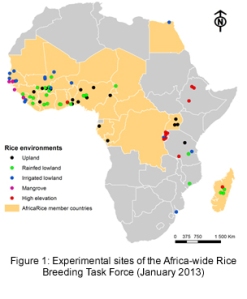Recently I visited Sierra Leone to discuss with the AfricaRice country coordinator based there (Bert Meertens) and our partners, in particular Dr Alfred Dixon from the Sierra Leone Agricultural Research Institute (SLARI). It is quite an adventure to visit Sierra Leone. Once you arrive at Lungi airport you still need to cross the Sierra Leone River. This time I took a speed boat (the alternative is a vintage Russian helicopter or you travel for a few hours by car over land) and arrived late at night at the other side of the river in Freetown. The next day I met with representatives from SLARI and the World Bank-funded West Africa Agricultural Productivity Program (WAAPP) project in an office in the very crowded center of town. Freetown gives the impression of being a bit suffocated — the possibilities to expand the city are apparently hampered by the surrounding lush green mountains.
For about 2 hours we discussed how to better coordinate rice research and development efforts in the country. Like other AfricaRice member countries, Sierra Leone has identified a number of ‘rice sector development hubs’. These hubs aim to facilitate integration of research products and local knowledge across the rice value chain to achieve development outcomes and impact. Hubs represent key rice-growing environments and different market opportunities and need to be linked to major national or regional rice-development efforts to facilitate broader uptake of rice knowledge and technologies. Sierra Leone has identified the following rice sector development hubs:
- Mambolo in Northern Province and Rotifunk in the Southern Province (mangrove)
- Bo and Kenema in Southern and Eastern Provinces (inland-valley swamp)
- Tormabum and Gbondapi in Southern Province (riverain grassland, deep flooded)
Activities in most of these hubs have started and currently involve identification of bottlenecks and opportunities across the rice value chain and testing of ‘good agricultural practices’ with farmers.
Next to concentrating research efforts in Hubs and proactively connecting with development partners from both public and private sectors, those who met generally felt that adoption pathways for research products need to be ‘anticipated’ as early as possible. For example, AfricaRice is about to finalize upgrading the NERICA-L 19 variety (very popular in Sierra Leone) with the sub-1 gene, which will make it flood tolerant in the early growth stages. Varieties upgraded with the sub-1 gene are already cultivated widely in Asia. The work on upgrading NERICA-L 19 and other popular African varieties is done in collaboration with the International Rice Research Institute (IRRI) within the framework of the Stress Tolerant Rice for Poor Farmers in Africa and South Asia (STRASA) project funded by the Bill & Melinda Gates Foundation. For Sierra Leone and neighboring countries there is a need to identify target areas for sub-1-upgraded varieties (e.g. using remote-sensing tools as has been done in Asia), clarify varietal release procedures and identify seed-multiplication partners.
In the afternoon we left for the SLARI research station in Rokupr, a small town in Northern Province, near the border of Guinea. The station is right in the middle of vast stretches of mangroves, inland-valley swamps and bolilands (seasonal swamps flooded for 2–4 months each year). It was established in 1934 as a rice experimental station and is being revamped after having suffered terribly in the civil war. It is still truly a beautiful campus with lots of potential, but, it must be said, very remote. It is a good 4 hours drive from Freetown. We saw many young faces, evidence that the recruitment wave of SLARI is paying off. These young people are currently being integrated into the rice research teams. Laboratories are generally well equipped, but mostly non-functional because of untrained staff, overly complex equipment, missing spare parts, and lack of electricity (available only 7 hours a day).
There were many opportunities during this trip to discuss Sierra Leone’s approach to rice sector development. Whereas Côte d’Ivoire seems to prefer a model heavily reliant on foreign investment (see my previous blog), Sierra Leone is taking farmer organizations as the entry point. Dr Dixon explained that these farmer organizations have often profited from knowledge gained in ‘farmer field schools’, facilitated by the Food and Agriculture Organization of the United Nations (FAO). They are now being grouped into ‘Agricultural Business Centers’ (ABCs) to commercialize agricultural products, including rice, in the framework of the Smallholder Commercialization Program established by the government. Almost 200 ABCs have now been established, out of a planned total of 600, and a lot of them produce lowland rice. They have been equipped with a standard set of infrastructure, such as mills, threshers and storage areas. The government is also helping farmers with rice commercialization by buying up rice during harvest and duty-free import of agricultural inputs. There is talk about establishing a national grain reserve to hold excess rice and manipulate rice flow for rice price adjustment when needed. ABCs are currently being ranked in terms of functionality by the Ministry of Agriculture, Forestry and Food Security.
Rice is clearly becoming serious business in Sierra Leone with farmer groups moving into the processing and marketing parts of the value chain. The honorable Minister of Agriculture, Forestry and Food Security, Mr Joseph Sam Sesay of Sierra Leone will be present at the upcoming Africa Rice Congress in Cameroon (21–24 October 2013) and will surely provide more insight in his country’s effort to boost the rice sector.

